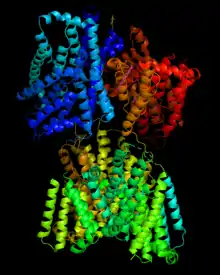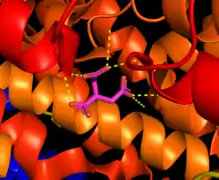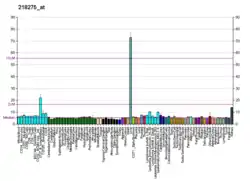Mitochondrial dicarboxylate carrier
The mitochondrial dicarboxylate carrier (DIC) is an integral membrane protein encoded by the SLC25A10 gene in humans that catalyzes the transport of dicarboxylates such as malonate, malate, and succinate across the inner mitochondrial membrane in exchange for phosphate, sulfate, and thiosulfate by a simultaneous antiport mechanism, thus supplying substrates for the Krebs cycle, gluconeogenesis, urea synthesis, fatty acid synthesis, and sulfur metabolism.[5][6][7][8][9]
Structure
The SLC25A10 gene is located on the q arm of chromosome 17 in position 25.3 and spans 8,781 base pairs.[8] The gene has 11 exons and produces a 31.3 kDa protein composed of 287 amino acids.[10][11] Intron 1 of this gene has five short Alu sequences.[12][13] Mitochondrial dicarboxylate carriers are dimers, each consisting of six transmembrane domains with both the N- and C- terminus exposed to the cytoplasm.[14] Like all mitochondrial carriers, dicarboxylate carriers features a tripartite structure with three repeats of about 100 amino acid residues, each of which contains a conserved sequence motif.[15] These three tandem sequences fold into two anti-parallel transmembrane α-helices linked by hydrophilic sequences.[6]


Function
A crucial function of dicarboxylate carriers is to export malate from the mitochondria in exchange for inorganic phosphate. Dicarboxylate carriers are highly abundant in the adipose tissue and play a central role in supplying cytosolic malate for the citrate transporter, which then exchanges cytosolic malate for mitochondrial citrate to begin fatty acid synthesis.[16] Abundant levels of DIC are also detected in the kidneys and liver, whereas lower levels are found in the lung, spleen, heart, and brain.[12] Dicarboxylate carriers are involved in glucose-stimulated insulin secretion through pyruvate cycling, which mediates NADPH production, and by providing cytosolic malate as a counter-substrate for citrate export.[17] It is also involved in reactive oxygen species (ROS) production through hyperpolarization of mitochondria and increases ROS levels when overexpressed.[18] Furthermore, dicarboxylate carriers are crucial for cellular respiration, and inhibition of DIC impairs complex I activity in mitochondria.[19]
Regulation
Insulin causes a dramatic (approximately 80%) reduction of DIC expression in mice, whereas free fatty acids induces DIC expression. Cold exposure, which increases energy expenditure and decreases fatty acid biosynthesis, resulted in a significant (approximately 50%) reduction of DIC expression.[14] DIC is inhibited by some dicarboxylate analogues, such as butylmalonate, as well as bathophenanthroline and thiol reagents such as Mersalyl and p-hydroxymercuribenzoate.[20][21][22] The activity of dicarboxylate carriers has also been found to be upregulated in plants in response to stress.[23] The rate of malonate uptake is inhibited by 2-oxoglutarate and unaffected by citrate, whereas the rates of succinate and malate uptake are inhibited by both 2-oxoglutarate and citrate.
Disease relevance
Suppression of SLC25A10 down-regulated fatty acid synthesis in mice, resulting in decreased lipid accumulation in adipocytes. Additionally, knockout of SLC25A10 inhibited insulin-stimulated lipogenesis in adipocytes. These findings presents a possible target for anti-obesity treatments.[16][24] It is also upregulated in tumors, which is likely because it regulates energy metabolism and redox homeostasis, both of which are frequently altered in tumor cells. In non-small cell lung cancer (NSCLC) cells, inhibition of SLC25A10 was found to increase the sensitivity to traditional anticancer drugs, and thus may present a potential target for anti-cancer strategies.[25] Furthermore, overexpression of dicarboxylate carriers in renal proximal tubular cells has been found to cause a reversion to a non-diabetic state and protect cells from oxidative injury. This finding supports the dicarboxylate carriers as a potential therapeutic target to correct underlying metabolic disturbances in diabetic nephropathy.[26]
Interactions
This protein has binary interactions with NOTCH2NL, KRTAP5-9, KRTAP4-2, KRTAP10-8, MDFI, and KRT40.[27][28]
See also
References
- GRCh38: Ensembl release 89: ENSG00000183048 - Ensembl, May 2017
- GRCm38: Ensembl release 89: ENSMUSG00000025792 - Ensembl, May 2017
- "Human PubMed Reference:". National Center for Biotechnology Information, U.S. National Library of Medicine.
- "Mouse PubMed Reference:". National Center for Biotechnology Information, U.S. National Library of Medicine.
- Dolce V, Cappello AR, Capobianco L (September 1997). "Mitochondrial tricarboxylate and dicarboxylate-tricarboxylate carriers: from animals to plants". IUBMB Life. 66 (7): 462–71. doi:10.1002/iub.1290. PMID 25045044. S2CID 21307218.
- Fiermonte G, Palmieri L, Dolce V, Lasorsa FM, Palmieri F, Runswick MJ, Walker JE (September 1998). "The sequence, bacterial expression, and functional reconstitution of the rat mitochondrial dicarboxylate transporter cloned via distant homologs in yeast and Caenorhabditis elegans". The Journal of Biological Chemistry. 273 (38): 24754–9. doi:10.1074/jbc.273.38.24754. PMID 9733776.
- Pannone E, Fiermonte G, Dolce V, Rocchi M, Palmieri F (Mar 1999). "Assignment of the human dicarboxylate carrier gene (DIC) to chromosome 17 band 17q25.3". Cytogenetics and Cell Genetics. 83 (3–4): 238–9. doi:10.1159/000015190. PMID 10072589. S2CID 38031823.
- "Entrez Gene: SLC25A10 solute carrier family 25 (mitochondrial carrier; dicarboxylate transporter), member 10".
- Palmieri L, Palmieri F, Runswick MJ, Walker JE (December 1996). "Identification by bacterial expression and functional reconstitution of the yeast genomic sequence encoding the mitochondrial dicarboxylate carrier protein". FEBS Letters. 399 (3): 299–302. doi:10.1016/S0014-5793(96)01350-6. PMID 8985166. S2CID 42731082.
- Zong NC, Li H, Li H, Lam MP, Jimenez RC, Kim CS, Deng N, Kim AK, Choi JH, Zelaya I, Liem D, Meyer D, Odeberg J, Fang C, Lu HJ, Xu T, Weiss J, Duan H, Uhlen M, Yates JR, Apweiler R, Ge J, Hermjakob H, Ping P (Oct 2013). "Integration of cardiac proteome biology and medicine by a specialized knowledgebase". Circulation Research. 113 (9): 1043–53. doi:10.1161/CIRCRESAHA.113.301151. PMC 4076475. PMID 23965338.
- "SLC25A10 - Mitochondrial dicarboxylate carrier". Cardiac Organellar Protein Atlas Knowledgebase (COPaKB).
- Fiermonte G, Dolce V, Arrigoni R, Runswick MJ, Walker JE, Palmieri F (December 1999). "Organization and sequence of the gene for the human mitochondrial dicarboxylate carrier: evolution of the carrier family". The Biochemical Journal. 344 (3): 953–60. doi:10.1042/bj3440953. PMC 1220721. PMID 10585886.
- Online Mendelian Inheritance in Man (OMIM): SLC25A10 - 606794
- Das K, Lewis RY, Combatsiaris TP, Lin Y, Shapiro L, Charron MJ, Scherer PE (December 1999). "Predominant expression of the mitochondrial dicarboxylate carrier in white adipose tissue". The Biochemical Journal. 344 (2): 313–20. doi:10.1042/0264-6021:3440313. PMC 1220646. PMID 10567211.
- Kunji ER (April 2004). "The role and structure of mitochondrial carriers". FEBS Letters. 564 (3): 239–44. doi:10.1016/S0014-5793(04)00242-X. PMID 15111103. S2CID 34604794.
- Mizuarai S, Miki S, Araki H, Takahashi K, Kotani H (September 2005). "Identification of dicarboxylate carrier Slc25a10 as malate transporter in de novo fatty acid synthesis". The Journal of Biological Chemistry. 280 (37): 32434–41. doi:10.1074/jbc.M503152200. PMID 16027120.
- Huypens P, Pillai R, Sheinin T, Schaefer S, Huang M, Odegaard ML, Ronnebaum SM, Wettig SD, Joseph JW (January 2011). "The dicarboxylate carrier plays a role in mitochondrial malate transport and in the regulation of glucose-stimulated insulin secretion from rat pancreatic beta cells". Diabetologia. 54 (1): 135–45. doi:10.1007/s00125-010-1923-5. PMID 20949348.
- Lin Y, Berg AH, Iyengar P, Lam TK, Giacca A, Combs TP, Rajala MW, Du X, Rollman B, Li W, Hawkins M, Barzilai N, Rhodes CJ, Fantus IG, Brownlee M, Scherer PE (February 2005). "The hyperglycemia-induced inflammatory response in adipocytes: the role of reactive oxygen species". The Journal of Biological Chemistry. 280 (6): 4617–26. doi:10.1074/jbc.M411863200. PMID 15536073.
- Kamga CK, Zhang SX, Wang Y (August 2010). "Dicarboxylate carrier-mediated glutathione transport is essential for reactive oxygen species homeostasis and normal respiration in rat brain mitochondria". American Journal of Physiology. Cell Physiology. 299 (2): C497-505. doi:10.1152/ajpcell.00058.2010. PMC 2928630. PMID 20538765.
- Chappell JB (May 1968). "Systems used for the transport of substrates into mitochondria". British Medical Bulletin. 24 (2): 150–7. doi:10.1093/oxfordjournals.bmb.a070618. PMID 5649935.
- Meijer AJ, Groot GS, Tager JM (May 1970). "Effect of sulphydryl-blocking reagents on mitochondrial anion-exchange reactions involving phosphate". FEBS Letters. 8 (1): 41–44. doi:10.1016/0014-5793(70)80220-4. PMID 11947527. S2CID 28153182.
- Passarella S, Palmieri F, Quagliariello E (December 1973). "The role of metal ions in the transport of substrates in mitochondria". FEBS Letters. 38 (1): 91–5. doi:10.1016/0014-5793(73)80521-6. PMID 4772695. S2CID 27910976.
- Palmieri F, Pierri CL, De Grassi A, Nunes-Nesi A, Fernie AR (April 2011). "Evolution, structure and function of mitochondrial carriers: a review with new insights". The Plant Journal. 66 (1): 161–81. doi:10.1111/j.1365-313X.2011.04516.x. hdl:11586/79017. PMID 21443630.
- Kulyté A, Ehrlund A, Arner P, Dahlman I (2017-06-01). "Global transcriptome profiling identifies KLF15 and SLC25A10 as modifiers of adipocytes insulin sensitivity in obese women". PLOS ONE. 12 (6): e0178485. Bibcode:2017PLoSO..1278485K. doi:10.1371/journal.pone.0178485. PMC 5453532. PMID 28570579.
- Zhou X, Paredes JA, Krishnan S, Curbo S, Karlsson A (April 2015). "The mitochondrial carrier SLC25A10 regulates cancer cell growth". Oncotarget. 6 (11): 9271–83. doi:10.18632/oncotarget.3375. PMC 4496216. PMID 25797253.
- Lash LH (July 2015). "Mitochondrial Glutathione in Diabetic Nephropathy". Journal of Clinical Medicine. 4 (7): 1428–47. doi:10.3390/jcm4071428. PMC 4519798. PMID 26239684.
- "SLC25A3 - Mitochondrial dicarboxylate carrier - Homo sapiens (Human) - SLC25A10 gene & protein". www.uniprot.org. Retrieved 2018-08-21.
 This article incorporates text available under the CC BY 4.0 license.
This article incorporates text available under the CC BY 4.0 license. - "UniProt: the universal protein knowledgebase". Nucleic Acids Research. 45 (D1): D158–D169. January 2017. doi:10.1093/nar/gkw1099. PMC 5210571. PMID 27899622.
Further reading
- Fiermonte G, Dolce V, Arrigoni R, Runswick MJ, Walker JE, Palmieri F (December 1999). "Organization and sequence of the gene for the human mitochondrial dicarboxylate carrier: evolution of the carrier family". The Biochemical Journal. 344 (3): 953–60. doi:10.1042/bj3440953. PMC 1220721. PMID 10585886.
- Douglas MW, Diefenbach RJ, Homa FL, Miranda-Saksena M, Rixon FJ, Vittone V, Byth K, Cunningham AL (July 2004). "Herpes simplex virus type 1 capsid protein VP26 interacts with dynein light chains RP3 and Tctex1 and plays a role in retrograde cellular transport". The Journal of Biological Chemistry. 279 (27): 28522–30. doi:10.1074/jbc.M311671200. PMID 15117959.
- Mizuarai S, Miki S, Araki H, Takahashi K, Kotani H (September 2005). "Identification of dicarboxylate carrier Slc25a10 as malate transporter in de novo fatty acid synthesis". The Journal of Biological Chemistry. 280 (37): 32434–41. doi:10.1074/jbc.M503152200. PMID 16027120.
- Khanna H, Hurd TW, Lillo C, Shu X, Parapuram SK, He S, Akimoto M, Wright AF, Margolis B, Williams DS, Swaroop A (September 2005). "RPGR-ORF15, which is mutated in retinitis pigmentosa, associates with SMC1, SMC3, and microtubule transport proteins". The Journal of Biological Chemistry. 280 (39): 33580–7. doi:10.1074/jbc.M505827200. PMC 1249479. PMID 16043481.
- Rual JF, Venkatesan K, Hao T, Hirozane-Kishikawa T, Dricot A, Li N, Berriz GF, Gibbons FD, Dreze M, Ayivi-Guedehoussou N, Klitgord N, Simon C, Boxem M, Milstein S, Rosenberg J, Goldberg DS, Zhang LV, Wong SL, Franklin G, Li S, Albala JS, Lim J, Fraughton C, Llamosas E, Cevik S, Bex C, Lamesch P, Sikorski RS, Vandenhaute J, Zoghbi HY, Smolyar A, Bosak S, Sequerra R, Doucette-Stamm L, Cusick ME, Hill DE, Roth FP, Vidal M (October 2005). "Towards a proteome-scale map of the human protein-protein interaction network". Nature. 437 (7062): 1173–8. Bibcode:2005Natur.437.1173R. doi:10.1038/nature04209. PMID 16189514. S2CID 4427026.
- Otsuki T, Ota T, Nishikawa T, Hayashi K, Suzuki Y, Yamamoto J, Wakamatsu A, Kimura K, Sakamoto K, Hatano N, Kawai Y, Ishii S, Saito K, Kojima S, Sugiyama T, Ono T, Okano K, Yoshikawa Y, Aotsuka S, Sasaki N, Hattori A, Okumura K, Nagai K, Sugano S, Isogai T (2007). "Signal sequence and keyword trap in silico for selection of full-length human cDNAs encoding secretion or membrane proteins from oligo-capped cDNA libraries". DNA Research. 12 (2): 117–26. doi:10.1093/dnares/12.2.117. PMID 16303743.
This article incorporates text from the United States National Library of Medicine, which is in the public domain.




